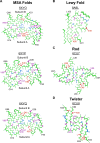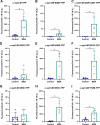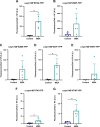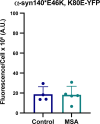This is a preprint.
Structurally targeted mutagenesis identifies key residues supporting -synuclein misfolding in multiple system atrophy
- PMID: 39026799
- PMCID: PMC11257492
- DOI: 10.1101/2024.07.04.602104
Structurally targeted mutagenesis identifies key residues supporting -synuclein misfolding in multiple system atrophy
Update in
-
Structurally targeted mutagenesis identifies key residues supporting α-synuclein misfolding in multiple system atrophy.J Parkinsons Dis. 2024 Nov;14(8):1543-1558. doi: 10.3233/JPD-240296. Epub 2024 Oct 17. J Parkinsons Dis. 2024. PMID: 39957201 Free PMC article.
Abstract
Multiple system atrophy (MSA) and Parkinson's disease (PD) are caused by misfolded -synuclein spreading throughout the central nervous system. While familial PD is linked to several point mutations in -synuclein, there are no known mutations associated with MSA. Our previous work investigating differences in -synuclein misfolding between the two disorders showed that the familial PD mutation E46K inhibits replication of MSA prions both in vitro and in vivo, providing key evidence to support the hypothesis that -synuclein adopts unique strains in patients. Here, to further interrogate -synuclein misfolding, we engineered a panel of cell lines harboring both PD-linked and novel mutations designed to identify key residues that facilitate -synuclein misfolding in MSA. These data were paired with in silico analyses using Maestro software to predict the effect of each mutation on the ability of -synuclein to misfold into one of the reported MSA cryo-electron microscopy conformations. In many cases, our modeling accurately identified mutations that facilitated or inhibited MSA replication. However, Maestro was occasionally unable to predict the effect of a mutation on MSA propagation in vitro, demonstrating the challenge of using computational tools to investigate intrinsically disordered proteins. Finally, we used our cellular models to determine the mechanism underlying the E46K-driven inhibition of MSA replication, finding that the E46/K80 salt bridge is necessary to support -synuclein misfolding. Overall, our studies use a structure-based approach to investigate -synuclein misfolding, resulting in the creation of a powerful panel of cell lines that can be used to interrogate MSA strain biology.
Conflict of interest statement
CONFLICT OF INTEREST S.H.O. and A.L.W. are the co-founders of Allagus Therapeutics, which did not contribute financial or any other support to these studies. S.H.O. and A.L.W. are inventors on U.S. Patent Application PCT/US2023/072173, which includes data reported here.
Figures





References
-
- Postuma RB, Berg D, Stern M, et al. MDS clinical diagnostic criteria for Parkinson’s disease. Mov Disord 2015; 30: 1591–1601. - PubMed
-
- Forster E and Lewy FH. Paralysis agitans. In: Lewandowsky M (ed) Pathologische Anatomie Handbuch der Neurologie. Berlin: Springer Verlag, 1912, pp.920–933.
Publication types
Grants and funding
LinkOut - more resources
Full Text Sources
